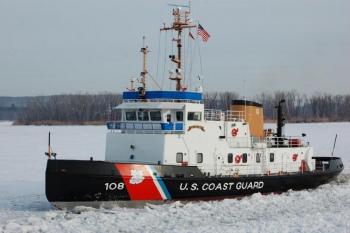ROCKLAND — Lt. Zac Bender is the commanding officer of the Coast Guard Cutter Thunder Bay, whose home port is Rockland. Thunder Bay returned home after a 61-day deployment on the Hudson River breaking up ice. It is part of the Coast Guard’s regional effort to ensure Northeast communities have security, supplies and emergency resources throughout the winter.
Thunder Bayis the eighth of nine 140-foot ice breaking tugboats in the Coast Guard’s fleet of the bay class. Six are based in the Great Lakes and three are in the Northeast, two in Bayonne, N.J., and one in Rockland.
Thunder Bay was built in the mid-1980s in Tacoma, Wash., commissioned in 1986 and sailed to Maine, where she has been ever since. The Thunder Bay has a crew of 17.
In January, the vessel coordinated daily ice breaking operations with Coast Guard cutters Sturgeon Bay, Willow, Elm, and Wire on the Hudson River. In order to keep the channel open to commercial shipping traffic, the Thunder Bay conducted operations seven days a week, with only occasional days off.
The vessel navigated more than 100 river miles daily and by the end of the season the Thunder Bay had motored nearly 3,000 nautical miles, conducted 554 hours of icebreaking, and made 70 vessel and facility break outs, requiring them to operate an additional 13 days beyond their original assignment.
“While it’s not the biggest ice breaker in the world, it’s very, very capable for its size,” said Bender. “It’s 140 feet long and 37 feet wide. That rounded shape is efficient for ice-breaking. The ship has a deep keel drawing 12 feet of water and it has a distinctive S-curve to the bow.”
The weight of the bow pushing down on the ice is what breaks the ice more then just pushing through it.
“It curves naturally down below the water line and then goes straight down before the keel,” said Bender. “That portion is called an ice knife and it prevents you from pushing up on the ice too far and potentially beaching the ship. The ice would have to be more than three feet thick to do that, but it’s built that way as a safety feature.”
Thunder Bay weighs 600 tons and is built soundly with an eight and a half-foot propeller that produces 2,500 shaft horsepower. The propeller produces a three-foot wake. Bender said it was akin to shaking out a blanket and enables them to break ice three times the width of the ship.
“The biggest thing is the ice-breaker hull, with the weight of the bow,” said Bender. “The plates are about 5/8 of an inch thick all the way around; it’s called an ice belt. Structurally, it’s densely built and big for her size.”
One special feature of the Thunder Bay is the hull air lubrication system.
“We call it the bubbler for short,” said Bender. “It’s a large air compressor on the back of the ship that creates high-volume, low-pressure air. When the system is activated it pushes the air out through a series of ports below the waterline. This creates a layer of air bubbles along the hull. And it gives us that little something extra to help break ice at speed more efficiently. On snow-covered ice, which we expect to see on the Penobscot River next week, the layer of air creates extra lubrication to reduce drag. Snow on ice creates a large amount of drag.”
Thunder Bay’s primary mission near Albany, on the Hudson River, was to keep commercial shipping lanes open.
The crew was responsible for maintaining the track and clearing choke points along the river. Even with ice-breaking assistance, a voyage that would normally take 18 hours in the summer would stretch to 40 hours this winter. Without Coast Guard ice breaking operation, the cargo carried by ships would not reach their destinations.
“The Port of Albany is a major commercial port during the winter time because they have tugboats pushing barges loaded with home heating oil and gasoline,” said Bender. “And, bulk carriers carry sand and salt and other boat commodities needed in the winter time.
“During the winter, the Hudson becomes the most reliable way to get things up north. A barge is carrying hundreds of thousands of barrels and that’s more than trains and dozens and dozens of trucks can carry. Our main focus is keeping the river open to commercial traffic and the people who use them.”
Thunder Bay’s next mission is to break ice jams on the Penobscot River.
“We’re moving into what we call the spring breakout of the Penobscot River,” said Bender. “Different form the operations in New York, the Penobscot River has no commercial traffic during the winter. The river freezes solid and, left to its own devises, it can create ice jams and lead to local flooding. We break up the ice to ensure it flows out and flushes out of the lower river. The Penobscot has ice that has built up in places to more than a foot thick. This winter it has a lot of snow on top. From the mouth of the river up to Bangor is about 23 nautical miles. Where we were working on the Hudson was more than 120 miles, so it’s a shorter distance, but pretty heavy ice.”


































